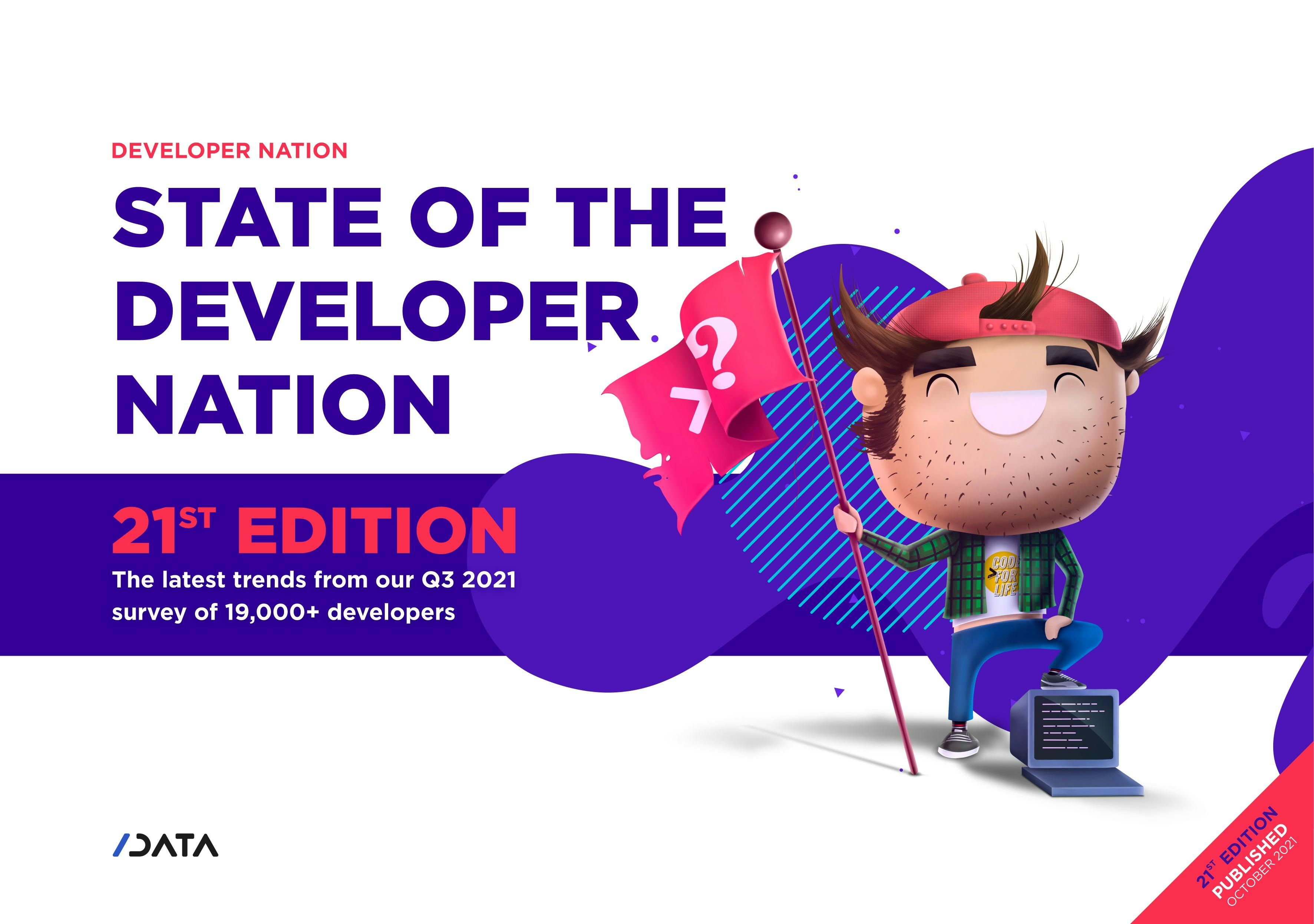
October 29, 2021
State of the Developer Nation 21st Edition - Q3 2021
SlashData Developer Economics is the leading research programme on mobile, desktop, industrial IoT, consumer electronics, embedded, third party app ecosystems, cloud, web, game, AR/VR and machine learning developers, as well as data scientists, tracking the developer experience across platforms, revenues, apps, languages, tools, APIs, segments, and regions.
The 21st edition of the Developer Nation global survey wave ran from June to August 2021 and reached more than 19,000 developers in 168 countries. This research report delves into key developer trends for Q3 2021 and beyond.
The report focuses on six major themes - each with its own visualisations - showing how the data lends insight into the developer community.
- Language communities - an update: Programming languages are often the kernels of strong communities and the subject of opinionated debate. In this chapter, we provide updated estimates of the number of active software developers using each of the major programming languages, across the globe and across all kinds of programmers.
- The developers at the heart of the 5G and IoT revolution: The fifth generation of mobile technology (5G) is upon us - ushering in a new era of hyper-connectivity. In this chapter, we explore how developers are involved in 5G worldwide and across different technology sectors, and we investigate how they are taking advantage of 5G for the rapidly expanding internet of things (IoT).
- What would make you leave your employer?: In our most recent survey, we asked professional developers what - if anything - would make them leave their current employer for another. This chapter takes a look at the most important motivations behind developers’ decisions to switch employers, including how these decisions are affected by the developers’ geographic location and experience level.
- Stages of the machine learning and data science workflow: As machine learning models become more complex, so do the infrastructure and working practices that underpin them. From data ingestion through to model deployment and lifecycle management, there are many different stages of the data science and machine learning workflow. In this chapter, we explore the stages which developers are involved in and how their involvement is changing over time.
- On developers who build apps and extensions for third-party platforms: Our digital world can be described as a collection of ecosystems filled with applications and services working alongside each other. Some services have evolved into their own platform, serving as a hub of opportunity for developers to build applications and extensions to enhance the platform’s functionality. This chapter takes a closer look at the developers who build applications for third-party ecosystems, the types of platforms and audiences they’re targeting, and the goals of their development.
- Technologies used in game development: Video games can be found everywhere; being sold as physical copies, digitally downloaded versions, or subscription-based access over the cloud. The availability and variety of game-ready devices has impacted the technologies game developers are using today. This chapter focusses on where game developers are deploying the code for their games and the technologies they’re leveraging to build their applications.
Methodology
The 21st edition of the Developer Nation survey reached 19,000+ respondents from 168 countries around the world. As such, the Developer Nation series of surveys continues to be the most global independent research on mobile, desktop, industrial IoT, consumer electronics, embedded, third-party app ecosystems, cloud, web, game, augmented and virtual reality, and machine learning developers and data scientists combined, ever conducted. The report is based on a large-scale, online developer survey designed, produced, and carried out by SlashData over a period of nine weeks between June and August 2021.
Respondents to the online survey came from 168 countries, including major app and machine learning development hotspots such as the US, China, India, Israel, the UK, and Russia, even stretching all the way to Kenya, Brazil, and Jordan. The geographic reach of this survey is truly reflective of the global scale of the developer economy. The online survey was translated into eight languages in addition to English, namely simplified Chinese, traditional Chinese, Spanish, Portuguese, Vietnamese, Russian, Japanese, and Korean, and was promoted by nearly 60 leading community and media partners within the software development industry.
Our respondents came from a broad age spectrum, from young coders who are under 18 to the seasoned ones over 55.. Respondents were asked which types of projects they are involved in out of the 13 under study, namely web apps / SaaS, mobile apps, desktop apps, backend services, augmented reality, virtual reality, games, data science, machine learning / artificial intelligence, industrial IoT, consumer electronics devices, embedded software, and apps/extensions for third-party app ecosystems. They also told us if they are into their areas of involvement as professionals, hobbyists, or students - or as any combination of these - and how many years of experience they have in each.
To eliminate the effect of regional sampling biases, we weighted the regional distribution across nine regions by a factor that was determined by the regional distribution and growth trends identified in our Developer Nation research. Each of the separate branches: mobile, desktop, Industrial IoT, consumer electronics, embedded software, third-party app ecosystems, cloud, web, games, augmented and virtual reality, and data science and machine learning were weighted independently and then combined.
To minimise other important sampling biases across our outreach channels, we weighted the responses to derive a representative distribution for technologies used and developer segments. Using ensemble modelling methods, we derived a weighted distribution based on data from independent, representative channels, excluding the channels of our research partners, to eliminate sampling bias due to respondents who were recruited via these channels. Again, this was performed separately for each of mobile, industrial IoT, consumer electronics, embedded software, third-party app ecosystems, desktop, cloud, web, games, augmented and virtual reality, and data science and machine learning.
For more information on our methodology please visit https://www.slashdata.co/methodology.
Contact us
Swan Buildings (1st floor)20 Swan StreetManchester, M4 5JW+441612400603community@developernation.net